High Gain and Wide-Angle Continuous Beam Scanning SIW Leaky-Wave Antenna
Abstract
:1. Introduction
2. Design and Analysis of SIW LWA
2.1. Design Theory
2.2. Geometry
3. Experimental Results
3.1. Geometry
3.2. S Parameters
3.3. Radiation Properties
4. Conclusions
Author Contributions
Funding
Informed Consent Statement
Data Availability Statement
Conflicts of Interest
References
- Hansen, W.W. Radiating Electromagnetic Waveguide. U.S. Patent 2,402,622,1940, 26 November 1940. [Google Scholar]
- Chen, S.L.; Karmokar, D.K.; Li, Z.; Qin, P.Y.; Ziolkowski, R.W.; Guo, Y.J. Circular polarized substrate integrated waveguide leaky-wave antenna with wide-angle and consistent-gain continuous beam scanning. IEEE Trans. Antennas Propag. 2019, 67, 4418–4428. [Google Scholar] [CrossRef]
- Fuscaldo, W.; Jackson, D.R.; Galli, A. General formulas for the beam properties of 1-D bidirectional leaky-wave antennas. IEEE Trans. Antennas Propag. 2019, 67, 3597–3608. [Google Scholar] [CrossRef]
- Arya, V.; Garg, T. Leaky Wave Antenna: Past and Present. In Proceedings of the Integrated Intelligence Enable Networks and Computing, Algorithms for Intelligent Systems, Chamoli, India, 5–7 September 2020. [Google Scholar] [CrossRef]
- Arya, V.; Garg, T. Leaky wave antenna: A historical development. Microw. Rev. 2021, 27, 3–16. [Google Scholar]
- Lyu, Y.; Member, S.; Liu, X. Leaky-wave antennas based on non-cutoff substrate integrated waveguide supporting beam scanning from backward to forward. IEEE Trans. Antennas Propag. 2016, 64, 2155–2164. [Google Scholar] [CrossRef]
- Sabahi, M.M.; Heidari, A.A.; Movahhedi, M. A compact CRLH circularly polarized leaky-wave antenna based on substrate integrated waveguide. IEEE Trans. Antennas Propag. 2018, 66, 4407–4414. [Google Scholar] [CrossRef]
- Paulotto, S.; Baccarelli, P.; Frezza, F.; Jackson, D.R. A novel technique for open-stopband suppression in 1-D periodic printed leaky-wave antennas. IEEE Trans. Antennas Propag. 2009, 57, 1894–1906. [Google Scholar] [CrossRef]
- Jackson, D.R.; Oliner, A.A. Leaky-Wave Antennas: Modern Antenna Handbook; Wiley: Hoboken, NJ, USA, 2008. [Google Scholar]
- Ranjan, R.; Ghosh, J. SIW based leaky wave antenna supporting wide range of beam scanning through broadside. IEEE Antenna Wirel. Propag. Lett. 2019, 18, 606–610. [Google Scholar] [CrossRef]
- Saghati, A.P.; Mirsalehi, M.M.; Neshati, M.H. A HMSIW circularly polarized leaky-wave antenna with backward, broadside, and forward radiation. IEEE Antennas Wirel. Propag. Lett. 2014, 13, 451–454. [Google Scholar] [CrossRef]
- Tiwari, A.K.; Awasthi, S.; Singh, R.K. A symmetrical periodic leaky wave antenna with backward to forward scanning. IEEE Antennas Wirel. Propag. Lett. 2020, 19, 646–650. [Google Scholar] [CrossRef]
- Paulotto, S.; Baccarelli, P.; Jackson, D. A self-matched wide scanning U-stub microstrip periodic leaky-wave antenna. J. Electr. Waves Appl. 2014, 28, 151–164. [Google Scholar] [CrossRef]
- Zheng, D.; Lyu, Y.-L.; Wu, K. Transversely slotted SIW leaky-wave antenna featuring rapid beam-scanning for millimeter-wave applications. IEEE Trans. Antennas Propag. 2020, 68, 4172–4185. [Google Scholar] [CrossRef]
- Karmokar, D.K.; Esselle, K.P. Periodic U-slot-loaded dual-band half-width microstrip leaky-wave antennas for forward and backward beam scanning. IEEE Trans. Antennas Propag. 2015, 63, 5372–5381. [Google Scholar] [CrossRef]
- Karmokar, D.K.; Guo, Y.J.; Qin, P.-Y.; Esselle, K.P.; Bird, T.S. Forward and backward beam-scanning Tri-band leaky-wave antenna. IEEE Antennas Wirel. Propag. Lett. 2017, 16, 1891–1894. [Google Scholar] [CrossRef]
- Nasimuddin; Chen, Z.N.; Qing, X. Multilayered composite right/left-handed leaky-wave antenna with consistent gain. IEEE Trans. Antennas Propag. 2012, 57, 5056–5062. [Google Scholar] [CrossRef]
- Kushiyama, Y.; Arima, T.; Uno, T. Differential type C.R.L.H. leaky-wave antenna using stepped impedance resonators. IEEE Antennas Wirel. Propag. Lett. 2016, 15, 321–324. [Google Scholar] [CrossRef]
- Cameron, T.R.; Sutinjo, A.T.; Okoniewski, M. A circularly polarized broadside radiating “Herringbone” array design with the leaky-wave approach. IEEE Antennas Wirel. Propag. Lett. 2010, 9, 826–829. [Google Scholar] [CrossRef]
- Mallahzadeh, A.; Mohammad-Ali-Nezhad, S. Periodic collinear slotted leaky wave antenna with open stopband elimination. IEEE Trans. Antennas Propag. 2015, 63, 5512–5521. [Google Scholar] [CrossRef] [Green Version]
- Williams, J.T.; Baccarelli, P.; Paulotto, S.; Jackson, D.R. 1-D combline leaky wave antenna with the open stopband suppressed: Design considerations and comparisons with measurements. IEEE Trans. Antennas Propag. 2013, 61, 4484–4492. [Google Scholar] [CrossRef]
- Tang, X.-L.; Zhang, Q.; Hu, S.; Zhuang, Y.; Kandwal, A.; Zhang, G.; Chen, Y. Continuous beam steering through broadside using asymmetrically modulated Goubau line leaky-wave antennas. Sci. Rep. 2011, 7, 11685. [Google Scholar] [CrossRef] [Green Version]
- Dong, Y.; Itoh, T. Composite right/left-handed substrate integrated waveguide and half mode substrate integrated waveguide leaky wave structures. IEEE Trans. Antennas Propag. 2011, 59, 767–775. [Google Scholar] [CrossRef]
- Liu, L.; Gu, X.; Zhu, L.; Rong, Y.; Qian, H. A novel half mode substrate integrated waveguide leaky-wave antenna with continu- ous forward-to-backward beam scanning functionality. Int. J. RF Microw. Comput. Eng. 2018, 28, e21559. [Google Scholar]
- Sarkar, A.; Adhikary, M.; Sharma, A.; Biswas, A.; Akhtar, M.J.; Hu, Z. Composite right/left-handed based compact and high gain leaky-wave antenna using complementary spiral resonator on HMSIW for Ku band applications. IET Microw. Antennas Propag. 2018, 12, 1310–1315. [Google Scholar] [CrossRef] [Green Version]
- Prakash, V.; Kumawat, S.; Singh, P. Design and analysis of full and half mode substrate integrated waveguide planar leaky wave antenna with continuous beam scanning in X-Ku band. Frequenz 2019, 73, 171–178. [Google Scholar] [CrossRef]
- Kamalzadeh, S.; Soleimani, M. A Novel SIW Leaky-Wave Antenna for Continuous Beam Scanning from Backward to Forward. Electronics 2022, 11, 1804. [Google Scholar] [CrossRef]
- Sohrabi, P.; Rezaei, P.; Kiani, S. A symmetrical SIW-based leaky—wave antenna with continuous beam scanning from from backward-to-forward through broadside. Wirel. Netw. 2021, 27, 5417–5424. [Google Scholar] [CrossRef]
- Zhou, W.; Liu, J.; Long, Y. Investigation of shorting vias for suppressing the open stopband in an SIW periodic leaky wave structure. IEEE Trans. Microw. Theory Tech. 2018, 66, 1–10. [Google Scholar] [CrossRef]
- Xu, F.; Wu, K. Guided wave and leakage characteristics of substrate integrated waveguide. IEEE Trans. Microw. Theory Tech. 2005, 53, 66–72. [Google Scholar]
- Liu, J.; Tang, X.; Li, Y.; Long, Y. Substrate integrated waveguide leaky-wave antenna with H-shaped slots. IEEE Trans. Antennas Propag. 2005, 60, 3962–3967. [Google Scholar] [CrossRef]
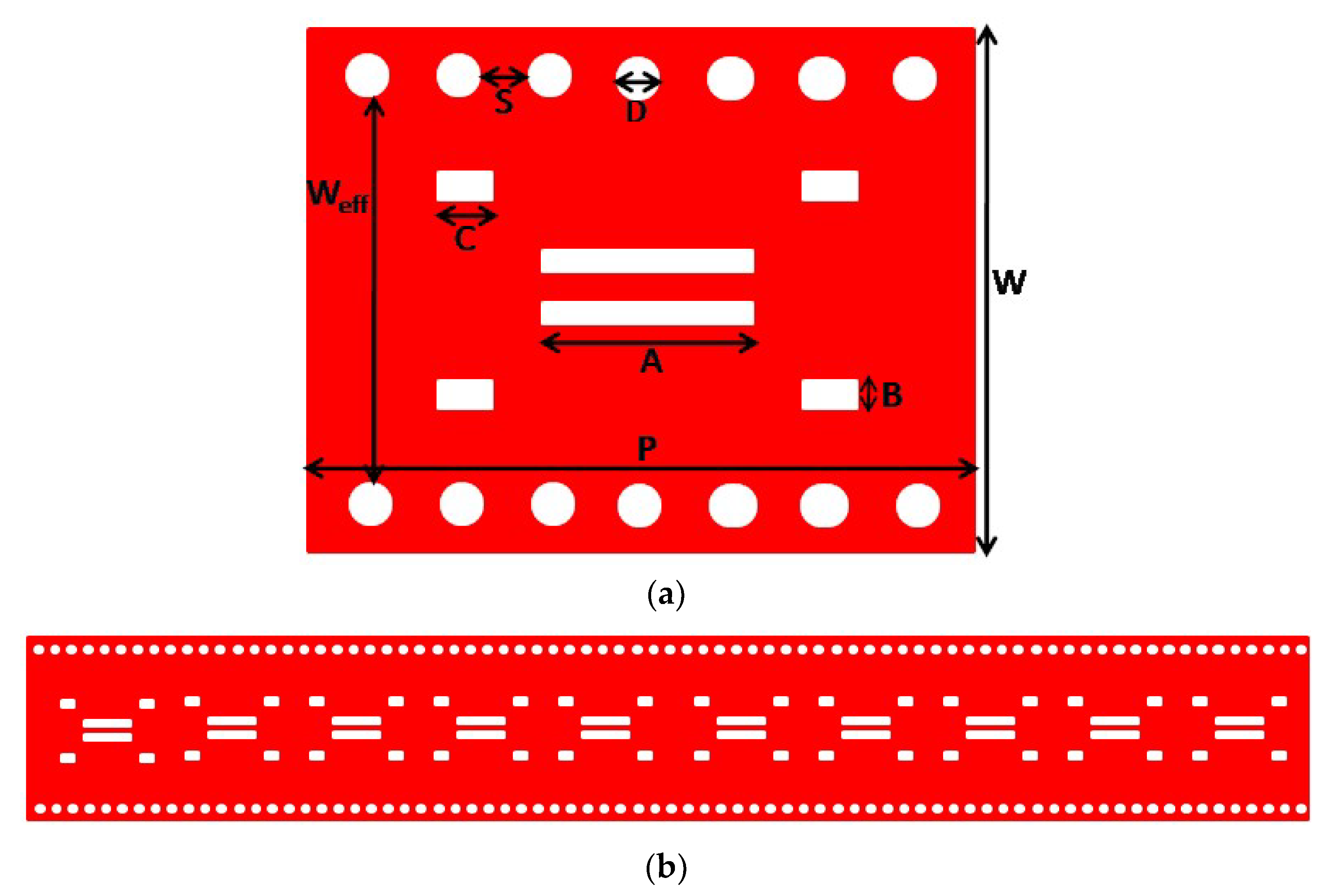
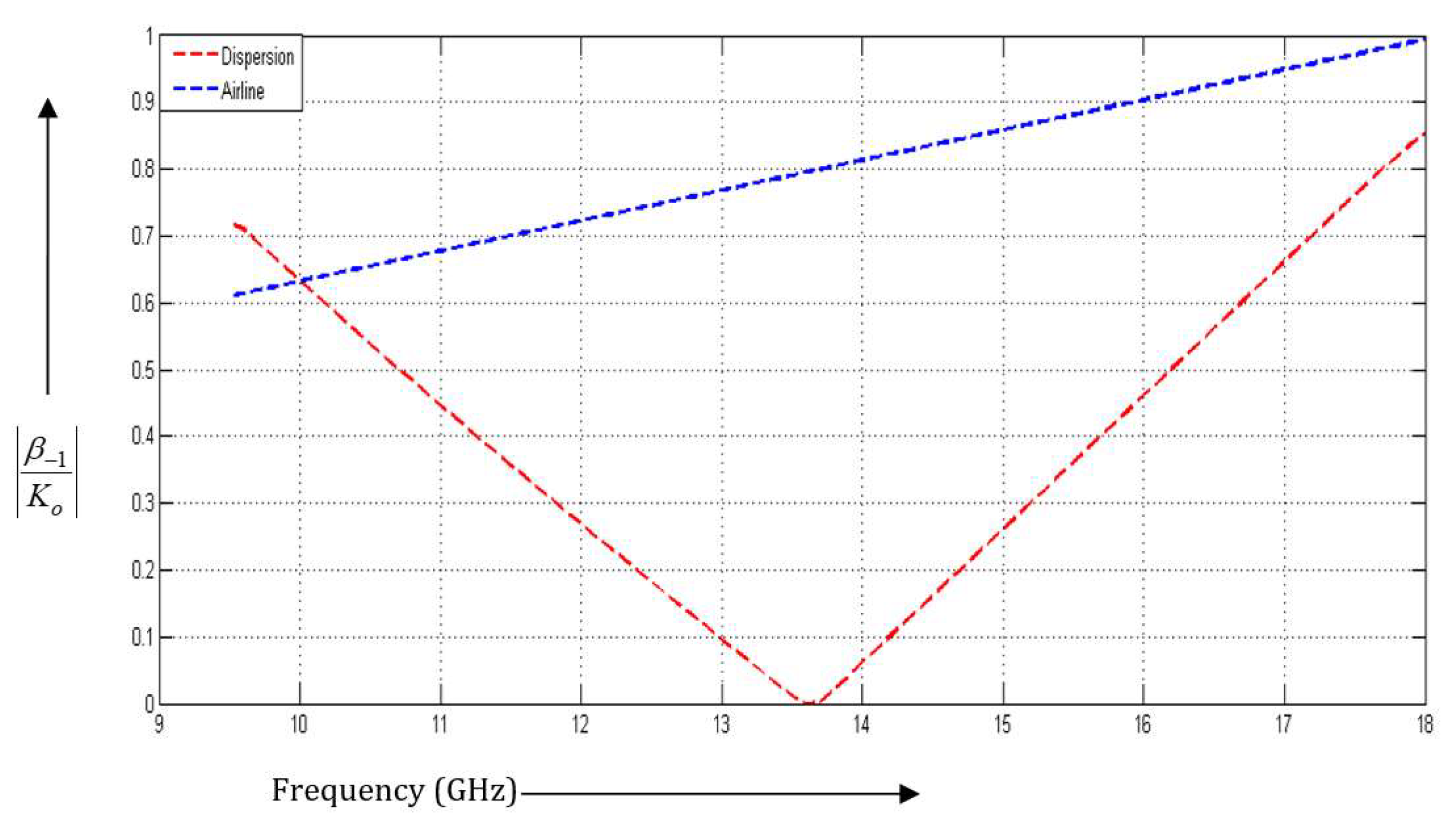
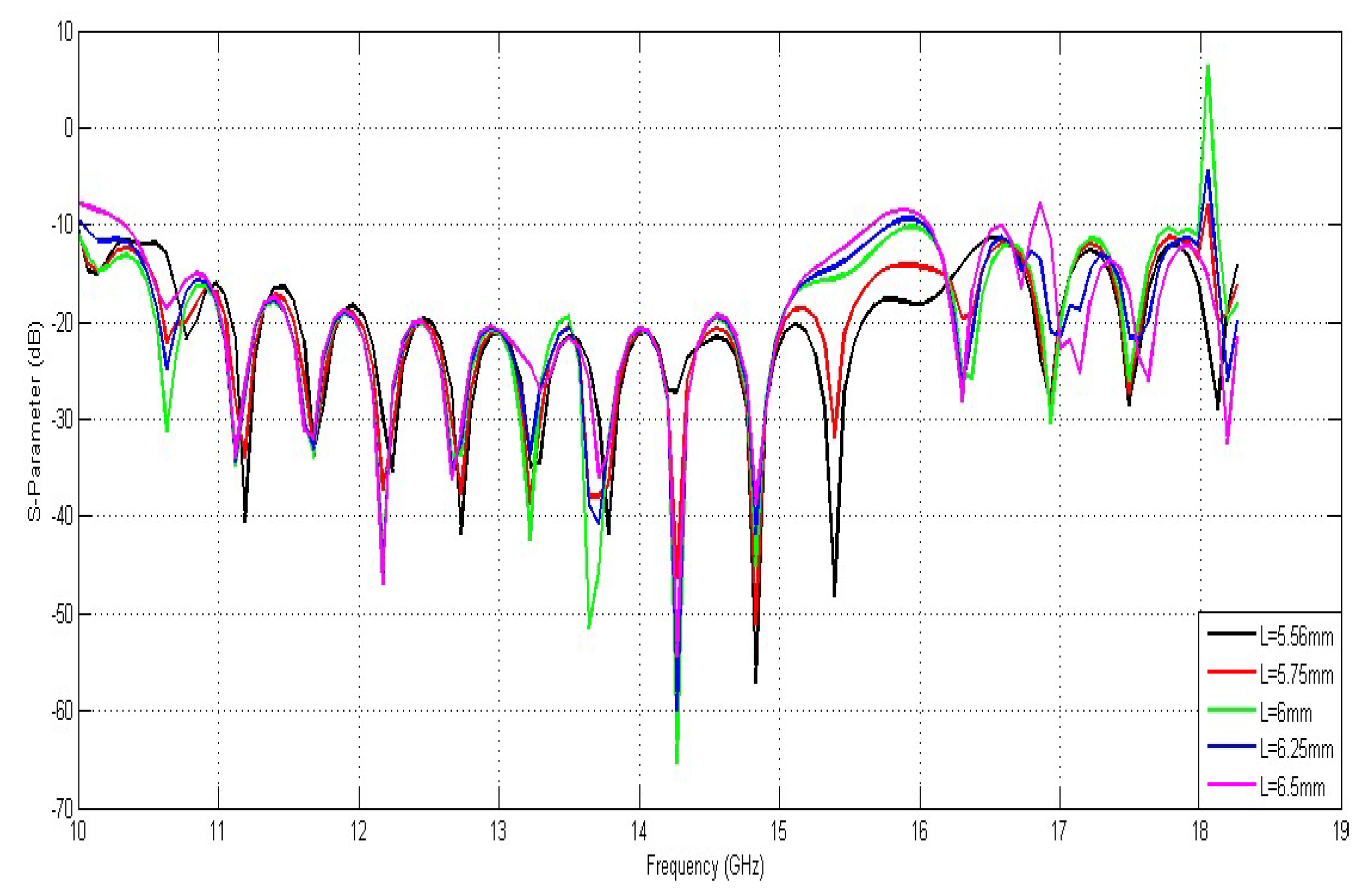



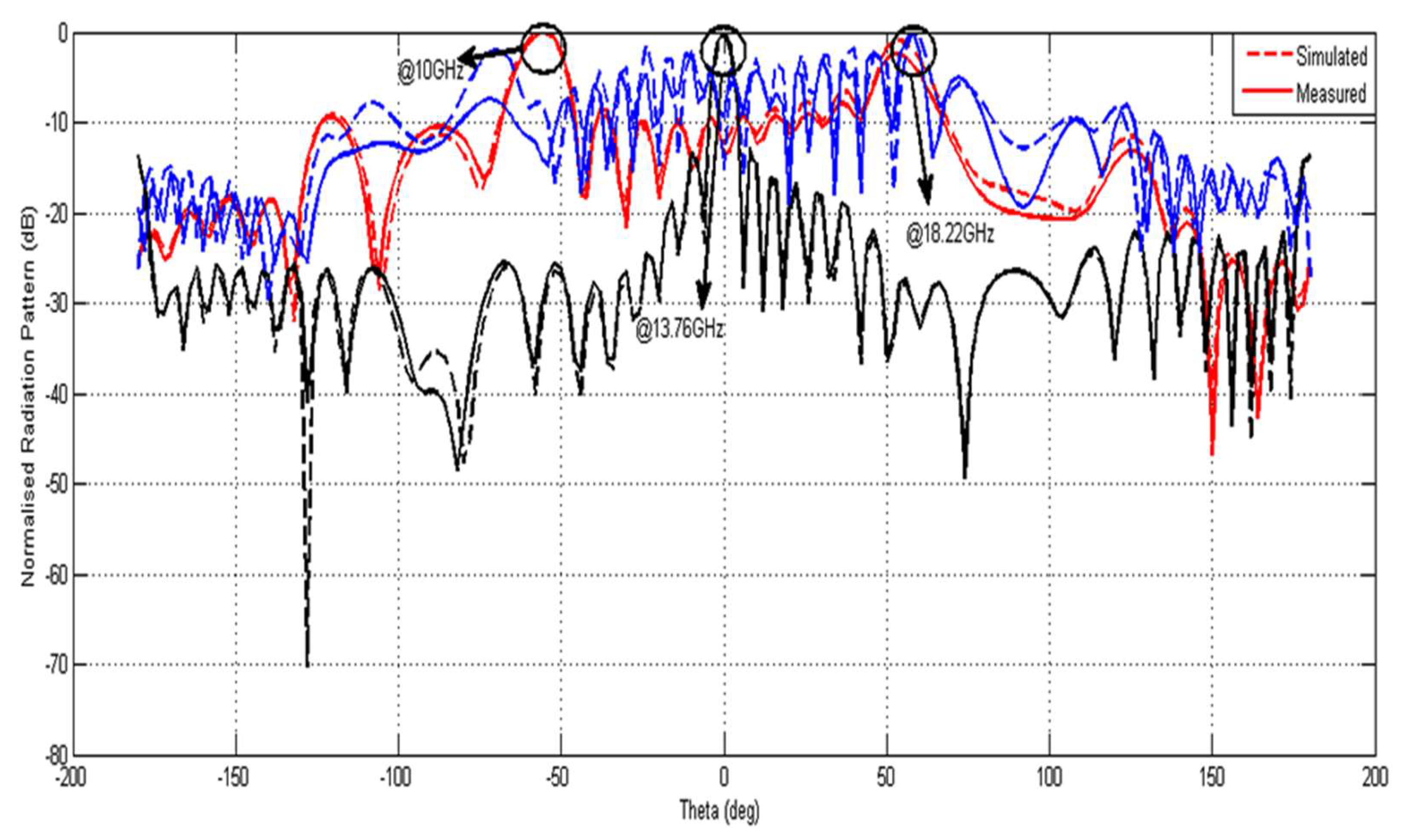

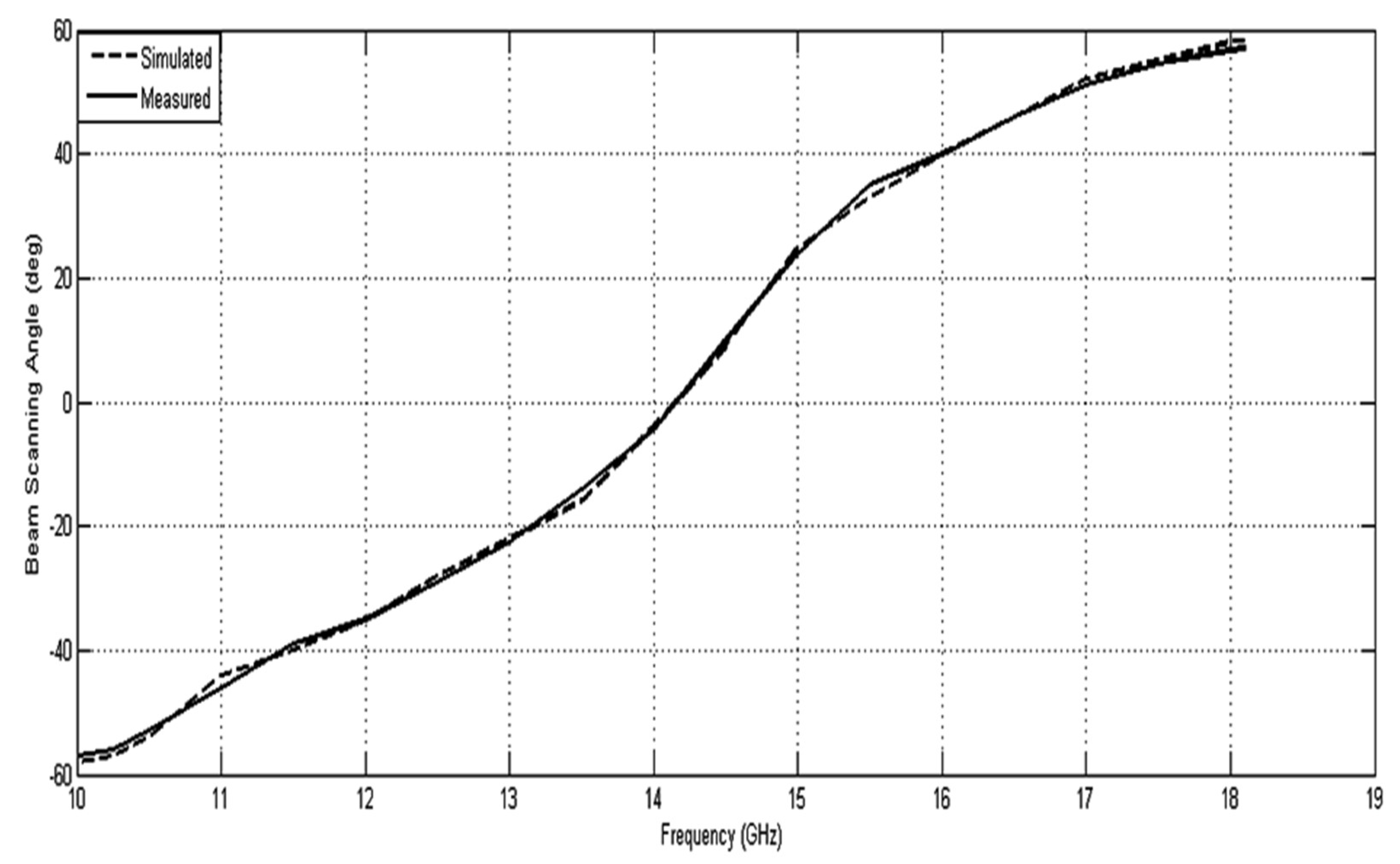
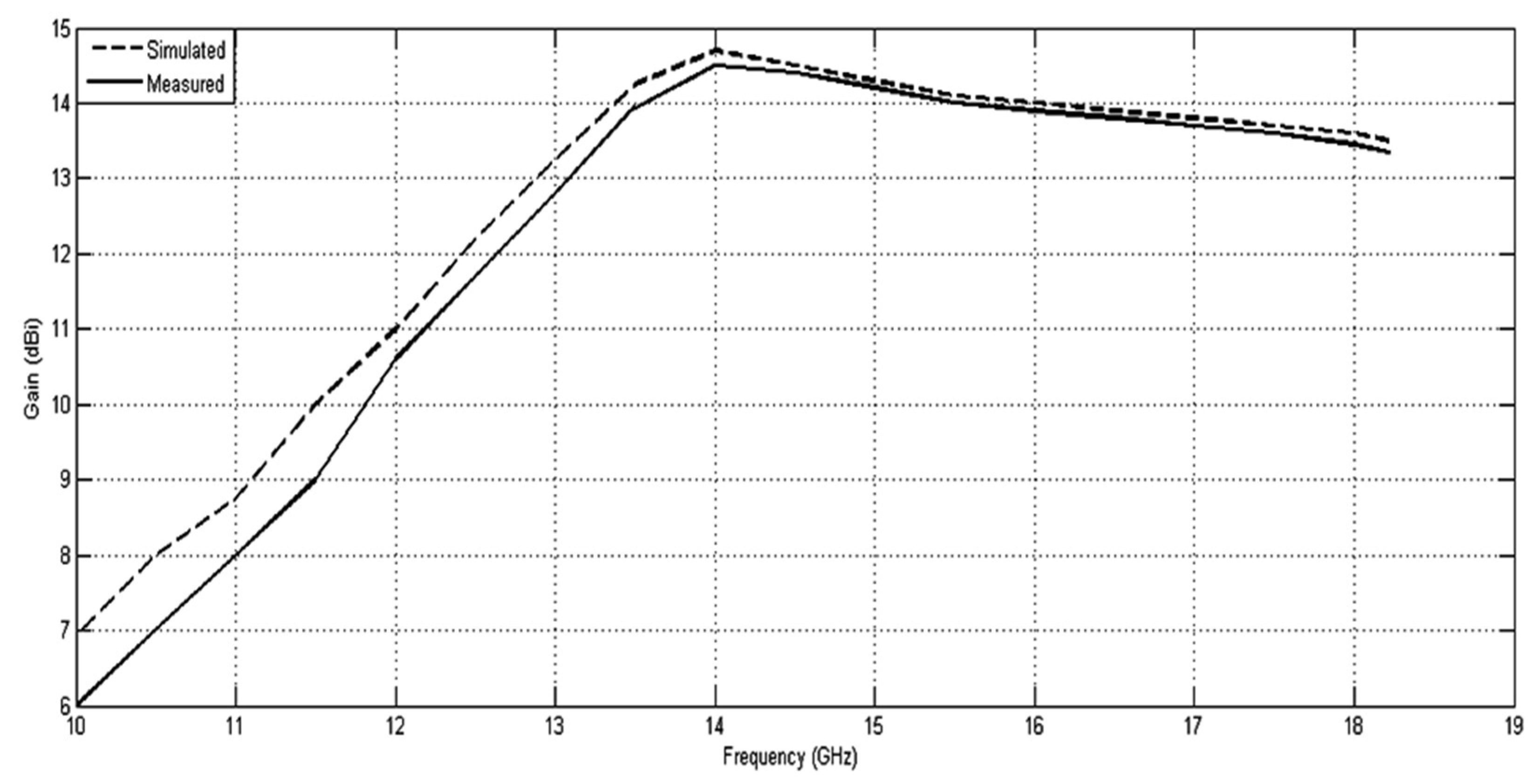
| Parameters | Values |
|---|---|
| W | 16 mm |
| Weff | 14 mm |
| P | 14.7 mm |
| A | 5.5 mm |
| B | 0.8 mm |
| C | 1.5 mm |
| S | 2 mm |
| D | 1 mm |
| Ref. | Type of Antenna | Length of Radiator | Scanning Frequency Range (GHz) | Backward to Forward Beam Scanning | Peak Gain |
|---|---|---|---|---|---|
| [6] | PSIW-LWA ) | ~7 | 9 to 14 | Yes (−40° to +35°) | ~12 dBi |
| [17] | Multilayered CRLH SIW PLWA ) | ~6 | 8 to 13 | Yes (−66° to +78°) | ~9 dBi |
| [18] | Microstrip Based CRLH PLWA ) | NA | 6.4 to 7.6 | Yes (−45° to +37°) | ~10 dBi |
| [19] | Microstrip Periodic LWA ) | ~6 | 7.2 to 8.2 | Yes (−25° to +15°) | ~12 dBi |
| [20] | Periodic RSIW LWA ) | NA | 8 to 12 | Yes (−35° to +35°) | ~11 dBi |
| [21] | Microstrip PLWA ) | ~30 | NA | Yes (NA) | ~21 dBi |
| [22] | PLWA Based on Goubau line ) | ~7 | 9 to 13 | Yes (−13° to +19°) | ~11.5 dBi |
| [23] | CRLH Based HMSIW LWA ) | ~5 | 8.5 to 12 | Yes (−35° to +37°) | ~10 dBi |
| [24] | Periodic HMSIW LWA ) | ~8 | 10 to 14 | Yes (−27° to +23°) | ~11.5 dBi |
| [25] | CRLH HMSIW LWA ) | ~4.85 | 13.5 to 17.8 | Yes (−66° to +20°) | ~16 dBi |
| [26] | Periodic SIW LWA ) PHMSIW LWA ) | ~6.84 ~6.84 | 10.17 to 16.3 10 to 16.5 | Yes (−38° to +22°) Yes (−50° to +26°) | ~11 dBi ~12 dBi |
| This work | SIW LWA ) | ~6.84 | 10 to 18.22 | Yes (−58° to +59°) | ~14.5 dBi |
Disclaimer/Publisher’s Note: The statements, opinions and data contained in all publications are solely those of the individual author(s) and contributor(s) and not of MDPI and/or the editor(s). MDPI and/or the editor(s) disclaim responsibility for any injury to people or property resulting from any ideas, methods, instructions or products referred to in the content. |
© 2023 by the authors. Licensee MDPI, Basel, Switzerland. This article is an open access article distributed under the terms and conditions of the Creative Commons Attribution (CC BY) license (https://creativecommons.org/licenses/by/4.0/).
Share and Cite
Arya, V.; Garg, T.; Al-Khafaji, H.M.R. High Gain and Wide-Angle Continuous Beam Scanning SIW Leaky-Wave Antenna. Electronics 2023, 12, 370. https://doi.org/10.3390/electronics12020370
Arya V, Garg T, Al-Khafaji HMR. High Gain and Wide-Angle Continuous Beam Scanning SIW Leaky-Wave Antenna. Electronics. 2023; 12(2):370. https://doi.org/10.3390/electronics12020370
Chicago/Turabian StyleArya, Vivek, Tanuj Garg, and Hamza Mohammed Ridha Al-Khafaji. 2023. "High Gain and Wide-Angle Continuous Beam Scanning SIW Leaky-Wave Antenna" Electronics 12, no. 2: 370. https://doi.org/10.3390/electronics12020370







